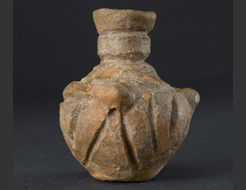|
||||||||||||||||||||||||||||||||
|
|
Museum of: Budapest | |||||||||||||||||||||||||||||||
| Name of the artefact: Miniature jar | ||||||||||||||||||||||||||||||||
|
Round flanked small jar |
||||||||||||||||||||||||||||||||
|
WHERE IS IT AND MAIN
CHARACTERISTICS |
STATE |
|||||||||||||||||||||||||||||||
|
Department: |
Department of Prehistoric and Migration
Period |
Preservation: |
Very good | |||||||||||||||||||||||||||||
|
Inventory number: |
BTM GY/523 |
Restauration: |
Restored | |||||||||||||||||||||||||||||
|
Name of the artefact: |
Miniature jar |
Completeness: |
Complete | |||||||||||||||||||||||||||||
|
Object type: |
Vessel/Anphora |
|||||||||||||||||||||||||||||||
|
Material: |
Clay |
|||||||||||||||||||||||||||||||
|
Methof of manufacture: |
Hand made |
|||||||||||||||||||||||||||||||
|
Decoration
type: |
Incision |
|||||||||||||||||||||||||||||||
|
Distinctive mark: |
- |
|||||||||||||||||||||||||||||||
|
DIMENSIONS |
PERIOD OF USE |
|||||||||||||||||||||||||||||||
|
Length (mm): |
- |
Epoque: |
Neolithic Age |
|||||||||||||||||||||||||||||
|
Heigth
(mm): |
64 |
Culture: |
Transdanubian Linear Pottery
Culture |
|||||||||||||||||||||||||||||
|
Diameter
(mm): |
22 |
Period: |
Middle Neolithic Age |
|||||||||||||||||||||||||||||
|
Width (mm): |
48 |
Face: |
Notenkopf-design phase |
|||||||||||||||||||||||||||||
|
Thickness (mm): |
- |
Absolute chronology: |
1st half 5th mil. BC |
|||||||||||||||||||||||||||||
|
Weight
(g): |
- |
|||||||||||||||||||||||||||||||
DISCOVERY |
||||||||||||||||||||||||||||||||
|
Date: |
2003 |
Country: |
Hungary |
|||||||||||||||||||||||||||||
|
District: |
Pest county |
Town hall affiliation: |
Biatorbágy |
|||||||||||||||||||||||||||||
|
Village: |
- |
Discovery findspot: |
Biatorbágy-Hosszúrétek |
|||||||||||||||||||||||||||||
|
Condition of discovery: |
Archaeological excavation |
Discovery type: |
Pit |
|||||||||||||||||||||||||||||
|
ANALYSES – DETERMINATIONS |
FILLED IN BY |
|||||||||||||||||||||||||||||||
|
Type: |
- |
Name: |
László András Horváth |
|||||||||||||||||||||||||||||
|
Laboratory: |
- |
Institution: |
Budapest History Museum |
|||||||||||||||||||||||||||||
|
No./Code: |
- |
Date: |
2005 |
|||||||||||||||||||||||||||||
|
DEEPENINGS |
||||||||||||||||||||||||||||||||
|
Morphology of the object: |
||||||||||||||||||||||||||||||||
|
Round flanked small jar. Its neck is elongated, the rim
slightly turning outwards. On the flank of the vessel are three, regularly
placed, slightly upward turning, vertically pierced suspension
handles. |
||||||||||||||||||||||||||||||||
|
Decoration: |
||||||||||||||||||||||||||||||||
|
On the lower half of the jar’s flank a wide band of
V-shaped patterns were incised flatly into the surface, connected together
by similarly executed horizontal lines on the lower sides of the
shoulders. Two parallel lines are incised on the neck. |
||||||||||||||||||||||||||||||||
|
Inscription: |
||||||||||||||||||||||||||||||||
|
- |
||||||||||||||||||||||||||||||||
|
Analogies: |
||||||||||||||||||||||||||||||||
|
- |
||||||||||||||||||||||||||||||||
|
Interpretation: |
||||||||||||||||||||||||||||||||
|
Based on the form and decoration of the pottery it can
be deduced that it fulfilled a special function different from everyday
use. Its small volume and the unusually narrow neck-diameter points to its
application in storing some unknown type of liquid, perfume, or other
volatile. Fitting to this function the small jar probably once had a
stopper which is now lost. The small handles could have been used to hang
up the vessel with a thin cord. |
||||||||||||||||||||||||||||||||
|
Bibliography: |
||||||||||||||||||||||||||||||||
|
Reményi L.– Tóth A.: Őskori telepek, római kori
árokrendszer, avar sírok Biatorbágy-Hosszúrétek lelőhelyen (Prehistoric
settlements, a ditch system from the Roman period, Avar graves at the site
of Biatorbágy-Hosszúrétek). In: Aquincum. Excavations and rescue work at
the Aquincum Museum in 2003. Bp. 2004. 160-167; Horváth L. A. – Reményi L.
– Tóth A.: Régészeti kutatások az M0 autóút bővítése kapcsán
(Archaeological excavations preceding the widening of highway M0. In:
Régészeti kutatások Magyarországon 2003 (Archaeological Investigations in
Hungary 2003) Budapest 2004. |
||||||||||||||||||||||||||||||||

